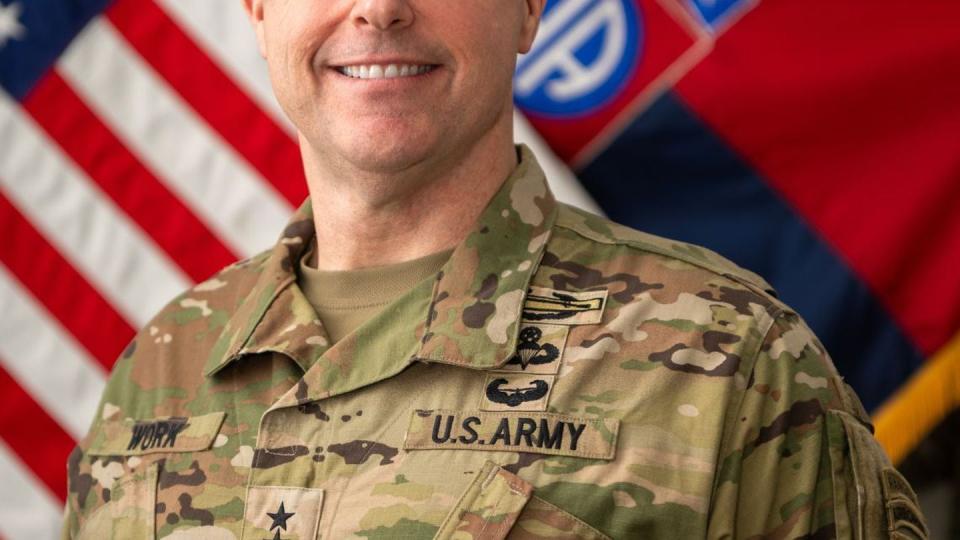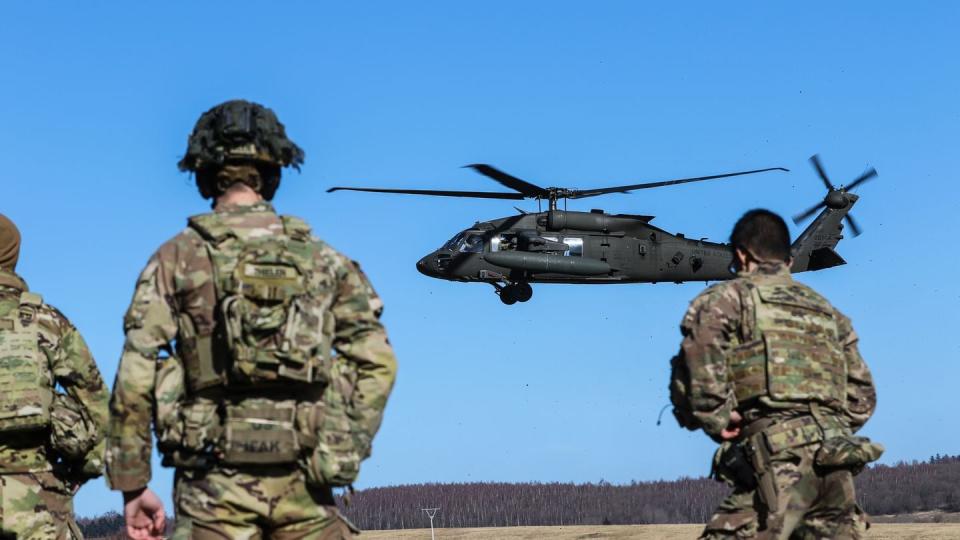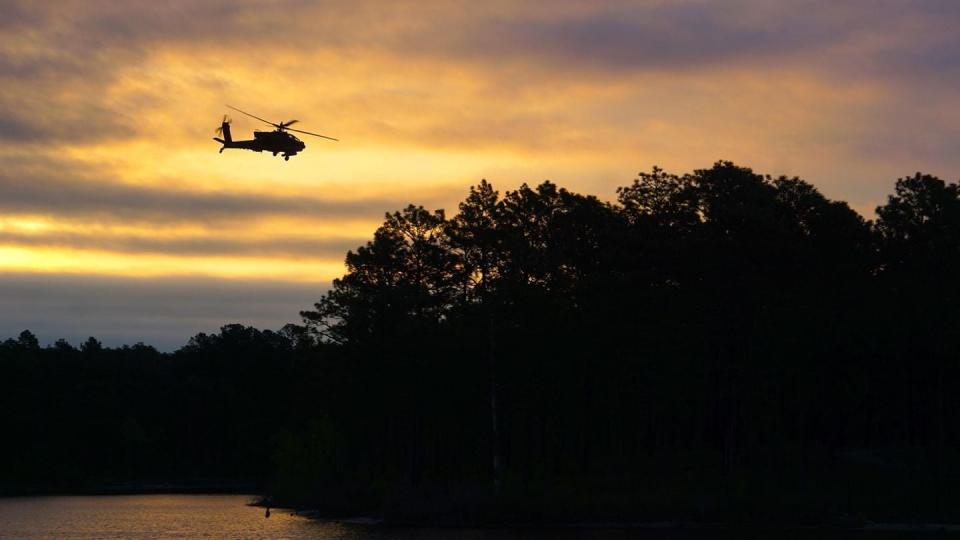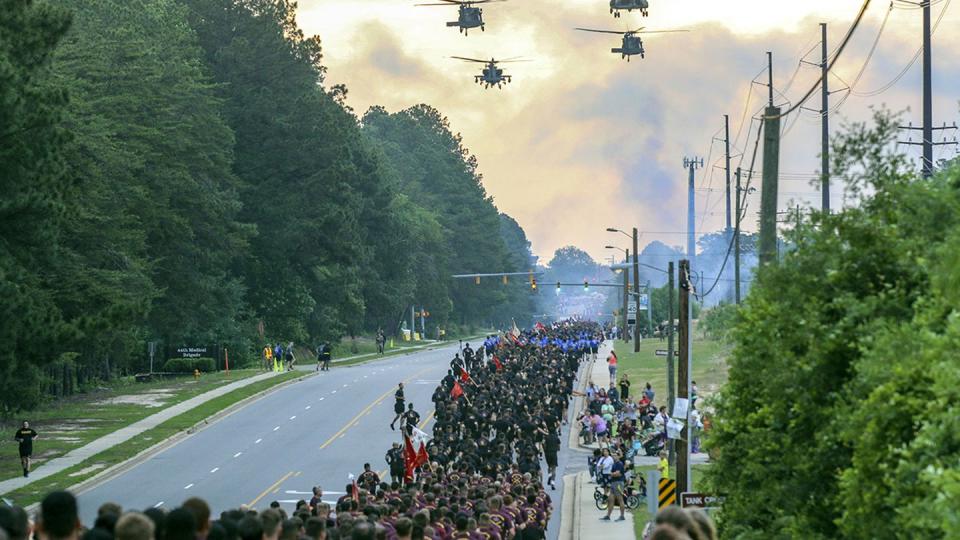Five questions for the 82nd Airborne Division’s commanding general
This article was published as part of a content-sharing agreement between Army Times and The Fayetteville Observer.
It’s been nearly six months since Maj. Gen. J. Patrick Work took command of the 82nd Airborne Division. The division’s headquarters deployed to Europe less than a month later, while the division’s combat aviation brigade headed to the Middle East.
Meanwhile, units back at Fort Liberty, North Carolina have trained locally, combined with annual training at the Joint Readiness Training Center at Fort Johnson, Louisiana, and the National Training Center at Fort Irwin, California. And the division’s Immediate Response Force maintains constant readiness to deploy if needed worldwide.
The Fayetteville Observer spoke with Work via a video call on May 6, while he was deployed to Europe, to catch up on what’s been going on in the division for the past six months.
Editor’s Note: The following Q&A has been edited for length, style and clarity.

What is the 82nd’s role in Europe right now?
Moscow’s invasion of Ukraine, with the initial invasion being in 2014 and then obviously again in 2022, the combat is vicious, and Romania shares a border with Ukraine. So the Black Sea region is really volatile, and there’s a whole lot at stake. The world is watching everything that’s playing out in Ukraine, and there’s no guarantees on how this thing’s going to end. So, when you think about the Alliance and you consider the investment that the United States and (Europe Command) made in the Baltic states of Poland in the beginning of 2014, we’re a little bit behind down here at the southeastern border.
What Gen. Chris Cavoli is trying to do with us is energize the Alliance, backstop the Alliance and encourage the Alliance in Slovakia, Hungary, Romania and Bulgaria, because this really is a rough neighborhood. The major commitment to Poland and the Baltic states occurred a decade prior to the reinvasion. Romania’s got a lot of potential. It’s got two national divisions. It’s got a NATO division that it hosts and a NATO Corps that it hosts. Bulgaria, Hungary and Slovakia, they’re principally focused on their national defenses, so what we’re trying to do through our Security Force Assistance is help connect their national efforts to the NATO efforts. So if you’re facing starting in the east along the Russian border and southeast flank of Europe, how do we help those three states connect deeply, more meaningfully to the alliance? That’s what we’re working on. Gen. Chris Cavoli clearly prioritize alliance efforts and energy toward the alliance.

The 82nd Combat Aviation Brigade has had a lot of training in the Middle East during the past few months. How is their deployment?
That’s obviously a very dangerous environment — since the very first week of October, even more so. It wrestles with counter-terrorism challenges within the region. Among many of those countries, some are really struggling with their own civil internal problems. Obviously, Syria deals with a civil war, but it’s based on what’s happened between Israel, Hamas and most recently Iran. It’s a really dangerous environment, and our aviation brigade is deployed right in the middle of that. And so, what happens between state actors doesn’t necessarily stay between those two states. We’re operating out of several countries throughout the Middle East right now. The Combat Aviation Brigade really defies physics. We can take for granted the skill it takes to fly helicopters. Every time it takes off, it’s defying gravity, and the pilots are extraordinarily skilled, and they do it day and night. That’s a really rough environment over there, just the heat and amount of sand, dirt, etc. They’re doing it to a very high standard, so we’re really proud of them, and we should never take for granted what those really skilled pilots do with those machines every day, and what those maintenance crews do behind the scenes to keep those aircraft flying. Not only are we proud of what they’re doing, but those paratroopers that are deployed to the Middle East right now are delivering every single day in a really difficult environment, and they’ve been doing so now for over six months.
A paratrooper was injured early during the deployment. Can you talk about the resiliency of the (families) here in North Carolina?
For those families dealing with separation right now, particularly the aviation brigade’s families where they know that their loved ones are operating in a dangerous environment — we’re really grateful. We tend to enlist soldiers but reenlist families, and the miracle of the all-volunteer force is that these families continue to stay with us, and we need them to do so. We’re extraordinarily grateful, and with great admiration, I say thank you on behalf of the nation and on behalf of the division. Additionally, Chief Warrant Officer 4 Garrett Illerbrunn had a very close call on Christmas Eve. At the better part of six months, he and his family have been coping with his recovery, and we’re all pulling for them and praying for them. For all the families affected by what’s happening in these wars, we keep you in our prayers and we keep you in our thoughts. They’re always in the front of my mind as commander.

Can you talk about the brigades back at Fort Liberty that have also been part of training cycles?
One of the things that we provide are ready and responsive forces on very short notice, and that’s no secret to anybody who watches. We’ve got the Immediate Response Force and their job is to be ready to deploy anywhere in the world in 18 hours to take on any enemy in any environment. We’ve also got a brigade combat team that’s on a slower alert and they’re in an intensive training cycle. Their job is to do mission-essential task training and everything from the individual up to the collective brigade combat team — all of those tasks from offense to defense to stability, and they’re really the division’s bread and butter, which is joint forcible entry — forcing our way into an adversary’s backyard, taking a piece of land from them so that we can help the nation build combat power as part of the joint force. We have a whole bunch of people right now that are out there trying to master their craft, whether it’s artillery fires, whether it’s engineers, whether they’re logisticians, or whether they’re infantry and they get paid to shoot, move, communicate and dominate in close combat. We have an entire brigade combat team focused on that right now, and then our division artillery and our sustainment brigade never get a day off. Every single time there’s a paratrooper in the field, someone put them there. Someone packed their parachute. Someone moved that ammunition. Someone’s firing those Howitzers to support them. So we got a lot going on in the division all the time.

Will the division have representatives at the 80th anniversary of the D-Day invasion?
A number of us are going to be there, and I’m very much looking forward to it. The 160,000 Allied troops that assaulted on D-Day, about 23,000 of them were paratroopers. They were paratroopers from the 82nd, from the 101st Airborne Division and from the British 6th Airborne Division. And from our division in particular, several of our regimental combat teams at the time conducted parachute assaults — the 505th, the 507th, the 508th and a handful of pathfinders from the 504th and then the 325th, which was a glider infantry regiment. All of those organizations participated in the assault landings on D-Day, and they fought doggedly in places like La Fiere, Rhines. Something interesting is that I’m deployed to Europe right now and I have a battalion from the 1st Infantry Division and a brigade from the 101st that are supporting over here. All those organizations made massive contributions during the Normandy campaign. And so for our division, over 33 days of sustained combat, 1,142 paratroopers paid the ultimate sacrifice. For units like the 508th that had over 2,000 jumpers on D-Day, when the boats came back a month later to England they only had about a thousand of them left. We owe them an exceptional kind of debt for the price they paid with their blood. I look forward to doing everything from getting over there honoring them at the various ceremonies such as St. Mere Eglise, the first city liberated within Normandy, which the 505th Parachute Infantry Regiment jumped on. We will head over to La Fiere bridge — the 505th fought doggedly; the 325th fought there; the 508th converged on there. We look forward to the opportunity, if the weather cooperates, to get out of an airplane and put on a show.
Staff writer Rachael Riley can be reached at rriley@fayobserver.com or 910-486-3528.

